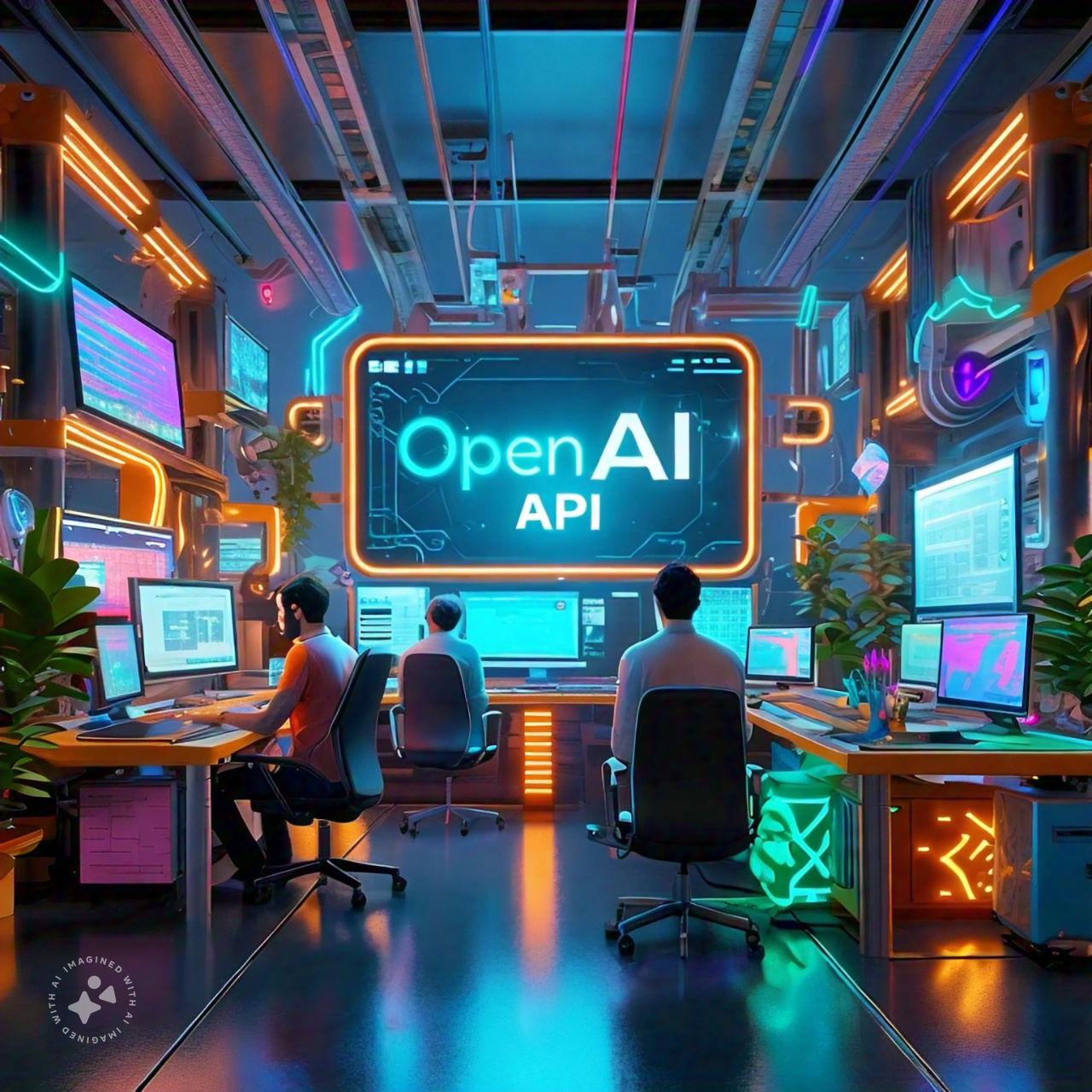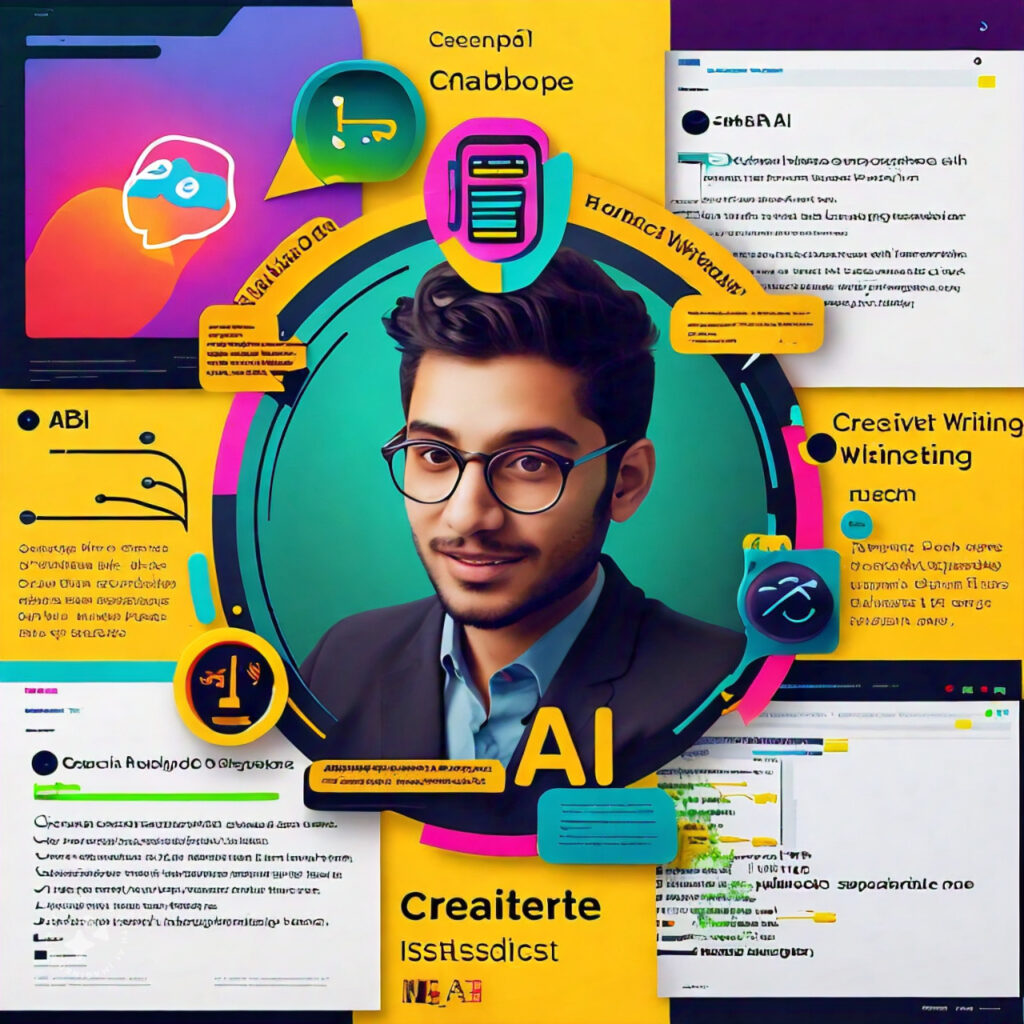
OpenAI API! Unleashing the Power of Artificial Intelligence
Did you know that in just five days, ChatGPT surpassed 1 million users Exploding Topics, 2024?
This mind-boggling statistic is just the tip of the iceberg when it comes to the revolutionary impact of OpenAI's technology.
 Caption: A collage of diverse AI applications built with the OpenAI API.
Caption: A collage of diverse AI applications built with the OpenAI API.Imagine harnessing that same power for your business, your research, or your next big idea.
That's exactly what the OpenAI API offers – a gateway to cutting-edge artificial intelligence at your fingertips.
The OpenAI API isn't just another tech tool; it's a paradigm shift in how we interact with AI. By providing access to pre-trained models like GPT-4,
which can understand and generate human-like text, and DALL-E, capable of creating images from textual descriptions,
OpenAI has democratized AI capabilities that were once the exclusive domain of tech giants OpenAI, 2024.
This means that whether you're a startup founder, a researcher, or a curious developer, you now have the power to integrate state-of-the-art AI into your projects with just a few lines of code.
As we stand on the brink of an AI revolution, how will the widespread accessibility of advanced AI models through
APIs like OpenAI's reshape our society, our work, and our very understanding of human creativity and intelligence?
Picture this: It's 2 AM, and Sarah, a solo entrepreneur, is burning the midnight oil trying to scale her customer support for her rapidly growing e-commerce business.
She can't afford a large team, but the inquiries are piling up. In desperation, she turns to the OpenAI API, integrating a chatbot powered by GPT-3.5 into her website.
Within hours, she's handling customer queries 24/7, providing personalized responses that sound remarkably human.
Sarah's story is just one example of how the OpenAI API is leveling the playing field, allowing individuals and small businesses to compete with industry giants.
The OpenAI API is not just a tool; it's a revolution in a box. Born from the ambitious mission of OpenAI, a company founded in 2015 by
tech luminaries including Elon Musk and Sam Altman, this API represents the culmination of years of cutting-edge research in artificial intelligence DataCamp, 2024.
But what exactly is the OpenAI API? At its core, it's a bridge – a sophisticated interface that allows developers,
businesses, and researchers to tap into some of the most advanced AI models ever created. Imagine having a brilliant AI assistant at your beck and call,
capable of understanding and generating human-like text, analyzing complex data, and even creating art. That's the power of the OpenAI API.
OpenAI API: Usage and Performance Statistics
API Usage by Model
Task Distribution
Performance Metrics
Metric
Value
Change
Average Response Time
0.5 seconds
↑ 20%
Accuracy Rate
95%
↑ 5%
Daily Active Users
1.2 million
↑ 15%
API Calls per Second
10,000
↑ 25%
The historical context of OpenAI is as fascinating as it is important. Founded as a non-profit organization, OpenAI's
initial goal was to ensure that artificial general intelligence (AGI) – AI systems that can outperform humans in most economically valuable work – would benefit all of humanity.
This lofty ambition has driven the company to push the boundaries of what's possible in AI, leading to groundbreaking developments like GPT-3 and DALL-E.
As of October 2024, OpenAI's impact is undeniable. With over 100 million weekly users flocking to ChatGPT, and the API powering innovations across industries,
from healthcare to finance to creative arts, we're witnessing the dawn of a new era in technology Reuters, 2024.
The latest developments are equally exciting. OpenAI recently introduced the GPT-4o model, pushing the boundaries of AI capabilities even further.
This model promises enhanced understanding of context, improved reasoning abilities, and even more natural language interactions OpenAI News, 2024.
As we delve deeper into the world of the OpenAI API, prepare to be amazed by its potential to transform industries, spark innovation, and perhaps even reshape the very fabric of our society.
Whether you're a tech enthusiast, a business leader, or simply curious about the future of AI, this journey into the heart of OpenAI's technology promises to be nothing short of revolutionary.
Understanding OpenAI Models
OpenAI has revolutionized the field of artificial intelligence with its cutting-edge models.
Let's dive into the capabilities of GPT-4 and DALL-E, and see how they compare to other AI development tools.
 Caption: A developer working on a laptop, exploring the OpenAI API on the OpenAI Playground.
Caption: A developer working on a laptop, exploring the OpenAI API on the OpenAI Playground.A. GPT-4 and its capabilities
GPT-4, the latest iteration of OpenAI's language model, has set new benchmarks in natural language processing.
This powerhouse of AI can understand and generate human-like text with unprecedented accuracy and nuance.
One of GPT-4's most impressive features is its ability to process and understand context across a wide range of topics.
According to OpenAI, GPT-4 can "solve difficult problems with greater accuracy, thanks to its broader general knowledge and problem solving abilities" OpenAI, 2024.
This versatility makes it invaluable for tasks ranging from creative writing to complex problem-solving.
In terms of performance, GPT-4 has shown remarkable improvements over its predecessor. It scored in the 90th percentile on the Uniform Bar Exam,
compared to GPT-3.5's 10th percentile score OpenAI, 2024. This leap in performance demonstrates GPT-4's
enhanced reasoning capabilities and its potential to revolutionize various industries.
OpenAI API: Unlocking the Power of AI
OpenAI Models
Explore GPT-4, DALL-E, and other cutting-edge AI models.
API Integration
Learn how to integrate OpenAI API into your projects seamlessly.
Use Cases
Discover diverse applications of OpenAI API across industries.
Chatbot Development
Build intelligent chatbots using OpenAI API step-by-step.
Ethical Considerations
Understand the importance of responsible AI development.
Performance Metrics
Analyze and optimize your AI model's performance.
Future Trends
Stay ahead with insights on upcoming AI developments.
Get Started
Take the first step in your AI journey with OpenAI API.
B. DALL-E and image generation
DALL-E, OpenAI's image generation model, has transformed the way we think about AI-created visuals. The latest version, DALL-E 3,
represents a significant leap forward in AI's ability to understand and create images based on textual descriptions.
DALL-E 3's capabilities are truly mind-boggling. It can generate, edit, and manipulate images with a level of detail and accuracy that was previously unimaginable.
According to OpenAI, "DALL·E 3 understands significantly more nuance and detail than our previous systems,
allowing you to easily translate your ideas into exceptionally accurate images" OpenAI, 2024.
The impact of DALL-E is already being felt across various industries. More than 2 million images are created by DALL-E 2 every day,
with over 1.5 million users visiting the platform daily Infobip, 2024. These numbers are expected to grow exponentially with the release of DALL-E 3.
Key Insights: OpenAI API
Revolutionizing AI Accessibility
OpenAI API democratizes access to advanced AI models, allowing developers of all sizes to integrate cutting-edge AI capabilities into their applications without the need for extensive AI expertise or infrastructure.
Learn More
Versatile Applications
From natural language processing to image generation, OpenAI API offers a wide range of capabilities that can be applied across various industries, including healthcare, finance, education, and creative arts.
Explore Use Cases
Ethical Considerations
As AI becomes more powerful, it's crucial to consider the ethical implications. OpenAI emphasizes responsible AI development and usage, encouraging developers to implement safeguards and consider potential biases in their AI applications.
Read Ethics Guidelines
Continuous Innovation
OpenAI consistently pushes the boundaries of AI technology. With regular updates and new model releases, developers can stay at the forefront of AI capabilities, ensuring their applications remain cutting-edge.
Check Latest Updates
C. Comparison with other AI Development Tools
While OpenAI's models are groundbreaking, it's important to understand how they stack up against other AI development tools in the market.
One key competitor is Google's Vertex AI. While OpenAI's GPT-4 excels in natural language processing, Vertex AI offers a more comprehensive suite of tools for machine learning and AI model management.
According to a recent comparison, "OpenAI's GPT-4 offers superior natural language processing capabilities,
making it the preferred choice for tasks that require advanced language understanding and generation" MarktechPost, 2024.
However, OpenAI's models are not without challenges. The cost of using these advanced models can be significant,
which may be a barrier for some users. Additionally, as with all AI models, there are ongoing discussions about bias and ethical use.
Despite these challenges, OpenAI continues to push the boundaries of what's possible with AI. The recent introduction of GPT-4o ("o" for "omni") marks another significant advancement.
This model can process and generate outputs across text, audio, and image modalities in real time, setting new records in multilingual and vision benchmarks Wikipedia, 2024.
As we look to the future, the potential of these AI models seems limitless. With ongoing research and development,
we can expect even more impressive capabilities in the coming years, further cementing OpenAI's position at the forefront of AI innovation.
Benefits of Using OpenAI API
The OpenAI API offers numerous advantages for businesses and developers looking to harness the power of artificial intelligence. Let's explore the key benefits in detail:
 Caption: A developer working with the OpenAI API.
Caption: A developer working with the OpenAI API.A. Enhanced productivity and efficiency
Integrating the OpenAI API into your workflows can significantly boost productivity and efficiency across various tasks.
For instance, content creation, which traditionally requires hours of human effort, can be streamlined using AI-powered tools.
According to a recent study by Accenture, AI has the potential to increase business productivity by up to 40% by 2035 Accenture's AI research.
The API's natural language processing capabilities can automate repetitive tasks such as data entry, customer service inquiries, and even basic coding.
This automation allows human employees to focus on more complex, creative, and strategic tasks that require uniquely human skills.
For example, in customer service, AI-powered chatbots can handle up to 80% of routine customer queries, freeing up human agents to deal with more complex issues Chatbot statistics.
This not only improves response times but also enhances overall customer satisfaction.
Key Features of OpenAI API
Natural Language Processing
Advanced language understanding and generation capabilities, enabling human-like text interactions and content creation.
Multi-model Support
Access to various AI models like GPT-3, GPT-4, and DALL-E, each optimized for different tasks and capabilities.
Customization Options
Fine-tuning capabilities allow developers to customize models for specific use cases and improve performance on domain-specific tasks.
Robust Security
Enterprise-grade security measures, including encryption and access controls, to protect sensitive data and ensure compliance.
Flexible Integration
Easy-to-use RESTful API and SDKs for various programming languages, enabling seamless integration into existing applications and workflows.
Scalability
Designed to handle high-volume requests, allowing applications to scale effortlessly from prototypes to production-ready systems.
B. Cost-effectiveness vs. in-house development
Developing AI capabilities in-house can be a costly and time-consuming endeavor. The OpenAI API offers a more cost-effective alternative,
allowing businesses to leverage state-of-the-art AI models without the need for extensive infrastructure or a team of AI specialists.
A report by Deloitte found that companies using pre-trained AI models like those offered by OpenAI can reduce
their AI development costs by up to 80% compared to building models from scratch Deloitte AI adoption survey.
Moreover, the pay-as-you-go pricing model of the OpenAI API allows businesses to scale their AI usage according to their needs, avoiding the high upfront costs associated with in-house AI development.
The Evolution of OpenAI API
2018: GPT-1 Release
OpenAI introduces GPT-1, laying the foundation for future language models.
2019: GPT-2 Advancement
GPT-2 showcases improved language understanding and generation capabilities.
2020: GPT-3 Launch
OpenAI releases GPT-3, a major leap in natural language processing technology.
2021: DALL-E Introduction
OpenAI unveils DALL-E, an AI model capable of generating images from text descriptions.
2022: ChatGPT Release
OpenAI launches ChatGPT, a conversational AI model that gains widespread popularity.
2023: GPT-4 Breakthrough
GPT-4 is released, offering enhanced capabilities and multimodal understanding.
2024: Future Innovations
OpenAI continues to push boundaries with new models and expanded API capabilities.
C. Scalability and flexibility
One of the most significant advantages of the OpenAI API is its scalability and flexibility. As your business grows or your AI needs change,
the API can easily accommodate increased demand without requiring substantial changes to your infrastructure.
The API supports a wide range of applications, from natural language processing to image generation, allowing businesses to adapt and
expand their AI capabilities as needed. This flexibility is crucial in today's rapidly evolving technological landscape.
For instance, OpenAI's GPT-3 model, accessible through the API, can be fine-tuned for specific tasks with relatively small amounts of training data.
This allows businesses to create custom AI solutions tailored to their unique needs without starting from scratch OpenAI fine-tuning guide.
Recent developments have further enhanced the API's capabilities. In October 2024, OpenAI introduced GPT-4 Turbo,
which offers a larger context window of 128,000 tokens, allowing for even more complex and nuanced AI interactions OpenAI GPT-4 announcement.
In conclusion, the OpenAI API offers significant benefits in terms of enhanced productivity, cost-effectiveness, and scalability.
https://justoborn.com/openai-api/
No comments:
Post a Comment